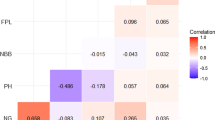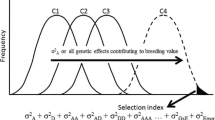Abstract
Little is known about the inheritance of agronomic traits in cassava, or on the relative importance of epistasis for most crops. A group of 10 clones, adapted to the acid-soils environment was used as parents in a diallel study. Thirty genotypes were obtained from each F1 cross and cloned. Each clone was represented by six plants, which were distributed in three replications at two contrasting locations. Genetic variability concentrated in the within-family component, which was statistically significant for all the variables analyzed (fresh root yield (FRY), fresh foliage yield (FFY), harvest index, root dry matter content, and plant type score (PTS)) except for the reaction to super elongation disease (SED). Estimates of dominance variance were considerably larger than those of additive variance for fresh root and foliage yields. The reverse was observed for harvest index, dry matter content, PTS and SED score. Epistasis played an important role only for fresh root and foliage productions. These results agree with those from similar studies targeting different environments. The common assumption of absence of significant epistatic effects frequent in many quantitative genetic designs is, therefore, challenged from the results for these two variables. Alternative breeding approaches are suggested according to the results obtained from this study.
Similar content being viewed by others
Abbreviations
- CBB:
-
cassava bacterial blight
- CET:
-
clonal evaluation trial
- DMC:
-
dry matter content
- FRY:
-
fresh root yield
- FFY:
-
fresh foliage yield
- GCA:
-
general combining ability
- PTS:
-
plant type score
- SCA:
-
specific combining ability
- SED:
-
score for the reaction to super elongation disease
References
Allard, R.W., 1960. Principles of Plant Breeding. Wiley, New York.
Becker, W.A., 1985. Manual of Quantitative Genetics, 4th edn., pp. 95–96. Academic Enterprises, Pullman, Washington.
Cach, N.T., J.I. Lenis, J.C. Perez, N. Morante, F. Calle & H. Ceballos, 2005. Inheritance of relevant traits in cassava (Manihot esculenta Crantz) for sub-humid conditions. J. Hered (in press).
Calle, F., J.C. Perez, W. Gaitán, N. Morante, H. Ceballos, G. Llano & E. Alvarez, 2005. Genetics of relevant traits in cassava (Manihot esculenta Crantz) adapted to acid-soil savannas. Euphytica (in press).
Ceballos, H., C.A. Iglesias, J.C. Pérez & A.G.O. Dixon, 2004. Cassava breeding: Opportunities and challenges. Plant Molecular Biology 56: 503–515.
Chávez, A.L., T. Sánchez, G. Jaramillo, J.M. Bedoya, J. Echeverry, E.A. Bolaños, H. Ceballos & C.A. Iglesias, 2005. Variation of quality traits in cassava roots evaluated in landraces and improved clones. Euphytica 143(1–2): 125–133.
CIAT, 2002. Annual report from IP3 project: Improved Cassava for the Developing World. CIAT, Apdo Aéreo 6713, Cali, Colombia.
Comstock, R.E., T. Kelleher & E.B. Morrow, 1958. Genetic variation in an asexual species, the garden strawberry. Genetics 43: 634–646.
Cortes, D.F., K. Reily, E. Okogbenin, J.R. Beeching, C. Iglesias & J. Tohme, 2002. Mapping wound-response genes involved in post-harvest physiological deterioration (PPD) of cassava (Manihot esculenta Crantz). Euphytica 128: 47–53.
Easwari Amma, C.S., M.N. Sheela & P.K. Thankamma Pillai, 1995. Combining ability analysis in cassava. J Root Crops 21(2): 65–71.
Easwari Amma, C.S. & M.N. Sheela, 1998. Genetic analysis in a diallel cross of inbred lines of cassava. Madras Agric J 85(5,6): 264–268.
FAO/FIDA, 2000. La economía mundial de la yuca. Hechos, tendencias y perspectivas. Fondo Internacional de Desarrollo Agrícola. Organización de las Naciones Unidas para la Agricultura y la Alimentación, Roma, Italy.
Foster, G.S. & D.V. Shaw, 1988. Using clonal replicates to explore genetic variation in a perennial plant species. Theor Appl Genet 76: 788–794.
Fregene, M., F. Angel, R. Gomez, F. Rodriguez, P. Chavarriaga, W. Roca, J. Tohme & M. Bonierbale, 1997. A molecular genetic map of cassava. Theor Appl Genet 95: 431–441.
Griffing, B., 1956. Concept of general and specific combining ability in relation to diallel crossing systems. Aust J Biol Sci 9: 463–493.
Hallauer, A.R. & J.B. Miranda-Fo, 1988. Quantitative Genetics in Maize Breeding, 2nd edn., pp. 45–114. Iowa State University Press, USA.
Hershey, C.H., 1984. Breeding cassava for adaptation to stress conditions: Development of a methodology. In: Proceedings of the 6th Symposium of the International Society for Tropical Root Crops, 20–25 February 1983, Lima, Peru.
Holland, J.B., 2001. Epistasis and plant breeding. Plant Breed Rev 21: 27–92.
Iglesias, C.A., C. Hershey, F. Calle & A. Bolaños, 1994. Propagating cassava (Manihot esculenta Crantz) by sexual seed. Exp Agric 30: 283–290.
Isik, F., B. Li & J. Frampton, 2003. Estimates of additive, dominance and epistatic genetic variances from a clonally replicated test of loblolly pine. Forest Sci 49(1): 77–88.
Jaramillo, G., N. Morante, J.C. Perez, F. Calle, H. Ceballos, B. Arias & A.C. Bellotti, 2005. Diallel analysis in cassava (Manihot esculenta Crantz) adapted to the mid-altitude valleys environment. Crop Sci (in press).
Jennings, D.L. & Iglesias, C.A., 2002. Breeding for crop improvement. In: R.J. Hillocks, J.M. Thresh and A.C. Bellotti (Eds.), Cassava: Biology, Production and Utilization, pp 149–166. CABI Publishing.
Jorge, V., M. Fregene, M.C. Duque, M.W. Bonierbale, J. Tohme & V. Verdier, 2000. Genetic mapping of resistance to bacterial blight disease in cassava (Manihot esculenta Crantz). Theor Appl Genet 101: 865–872.
Jorge, V., M. Fregene, C.M. Velez, M.C. Duque, J. Tohme & V. Verdier, 2001. QTL analysis of field resistance to Xanthomonas axonopodis pv. manihotis in cassava. Theor Appl Genet 102: 564–571.
Kao, C.H. & Z.B. Zeng, 2002. Modeling epistasis of quantitative trait loci using Cockerham's model. Genetics 160(3): 1243–1261.
Kawano, K., 1980. Cassava. In: W.R. Fehr & H.H. Hadley (Eds.), Hybridization of Crop Plants, pp. 225–233. ASA, CSSA. Madison, Wisconsin, USA.
Kawano, K., A. Amaya, P. Daza & M. Ríos, 1978. Factors affecting efficiency of hybridization and selection in cassava. Crop Sci 17: 373–376.
Kawano, K., W.M. Gonçalvez Fukuda & U. Cenpukdee, 1987. Genetic and environmental effects on dry matter content of cassava root. Crop Sci 27: 69–74.
Libby, W.J. & E. Jund, 1962. Variance associated with cloning. Heredity 17: 533–540.
Losada, V.-T., 1990. Cruzamentos dialélicos em mandioca (Manihot esculenta Crantz), 180 p. Ph.D. Dissertation. Piracicaba, SP, Brazil, Escola Superior de Agricultura Luiz de Queiroz, Universidade de São Paulo.
Lynch, M. & B. Walsh, 1998. Genetics and analysis of quantitative traits. Sinauer Associates, pp. 558–563, Chapter 18 and pp. 813–816, Appendix 1.
Mba, R.E.C., P. Stephenson, K. Edwards, S. Melzer, J. Mkumbira, U. Gullberg, K. Apel, M. Gale, J. Tohme & M. Fregene, 2001. Simple sequence repeat (SSR) markers survey of the cassava (Manihot esculenta Crantz) genome: Towards an SSR-based molecular genetic map of cassava. Theor Appl Genet 102: 21–31.
Okogbenin, E. & M. Fregene, 2003. Genetic mapping of QTLs affecting productivity and plant architecture in a full-sib cross from non-inbred parents in cassava (Manihot esculenta Crantz). Theor Appl Genet 107: 1452–1462.
Perez, J.C., H. Ceballos, G. Jaramillo, N. Morante, F. Calle, B. Arias & A.C. Bellotti, 2005. Analysis of the importance of epistasis in cassava (Manihot esculenta Crantz) adapted to the mid-altitude valleys environment. Crop Sci (in press).
Rönnberg-Wästljung, A.C. & U. Gullberg, 1999. Genetics of breeding characters with possible effects on biomass production in Salix viminalis (L.). Theor Appl Genet 98: 531–540.
Rönnberg-Wästljung, A.C., U. Gullberg & C. Nilsson, 1994. Genetic parameters of growth characters in Salix viminalis grown in Sweden. Can J For Res 24: 1960–1969.
Scott, G.J., M.K. Rosegrant & C. Ringler, 2000a. Global projections for root and tuber crops to the year 2020. Food Policy 25: 561–597.
Scott, G.J., M.K. Rosegrant & C. Ringler, 2000b. Salix viminalis grown in Sweden. Can J For Res 24: 1960–1969.
Stonecypher, R.W. & R.B. McCullough, 1986. Estimates of additive and non-additive genetic variance from a cloneal diallel of Douglas-fir Pseudotsuga menziesii (Mirb.) Franco. In: Proceedings of the International Union of Forest Research Organization, A Joint Meeting of the Working Parties on Breeding Theory, Progeny Testing, and Seed Orchads, Williamsburg/VA, pp. 211-227. NCSU-Industry Cooperative Tree Improvement Program.
Vega, O.-P.C., 1987. Introducción a la teoría de genética cuantitativa. Universidad Central de Venezuela Press, Caracas.
Vencovsky, R. & P. Barriga, 1992. Genética Biométrica no Fitomelhoramento, 486 pp. Sociedade Brasileira de Genética. Ribeirão Preto, Brasil.
Author information
Authors and Affiliations
Corresponding author
Rights and permissions
About this article
Cite this article
Perez, J.C., Ceballos, H., Calle, F. et al. Within-family genetic variation and epistasis in cassava (Manihot esculenta Crantz) adapted to the acid-soils environment. Euphytica 145, 77–85 (2005). https://doi.org/10.1007/s10681-005-0424-y
Received:
Accepted:
Issue Date:
DOI: https://doi.org/10.1007/s10681-005-0424-y




